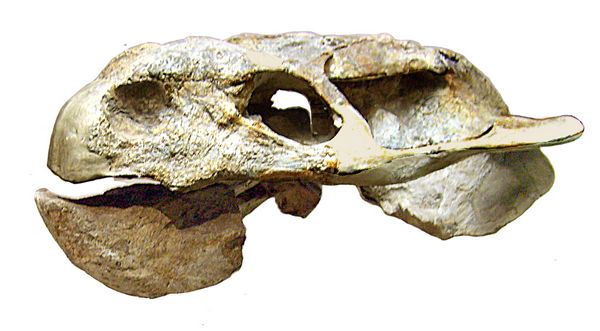Athena Review Image Archive ™
Oudenodon bainii skull

Skull of Oudenodon bainii (Berlin Mus.Nat.Hist. )
Oudenodon was a dicynodont therapsid common throughout South Africa in the Late Permian (265-252 mya), and has also been found in Madagascar, Zambia, and India (Ray 1999; Bandyopadhyay 1999). Oudenodon belongs to the clade Therapsida, and the infraorder Dicynodonta. Oudenodon is the type genus of the family Oudenodontidae, which also includes Cteniosaurus, Tropidostoma, and Rhachiocephalus.
Several species of Oudenodon are known. Both Oudenodon bainii, the type species named by Owen (1860), and O. grandis are from South Africa. O. luangwensis is from Zambia, and O. sakamenensis is the only therapsid yet known from Madagascar (Mazin and King 1991).
Even though classed with dicynodonta ("two dog teeth"), Oudenodon had no teeth. The Oudenodontidae family have a deep, thin walled cleft in the lower jaw for anchoring the horny platform. They had a very precise cutting and crushing surface between the beaks, where the rim of the maxilla was pointed downward. The skull was directed forwards, thus adapted to feeding at levels approximately 20-100 cm above the ground (King 1990). This shows a new level of diversification, away from substrate-feeding.
References:
Bandyopadhyay, S. 1999. Gondwana Vertebrate Faunas of India. PINSA 65, pp. 285-313.
King, G.M. 1990. The Dicynodonts: A Study in Palaeobiology. Chapman & Hall.
Mazin, J. M. and King, G. M. 1991. The first dicynodont from the Late Permian of Malagasy. Palaeontology 34, pp.837–842.
Owen, R. 1860. On some reptilian fossils from South Africa. Quaternary Journal of the Geological Association of South Africa 67:1-110.
Ray, S. 1999. Permian Reptilian Fauna from the Kundaram Formation, Pranhita- Godavari Valley, India. Journal of African Earth Sciences, 29 (1), pp.211-218.
Copyright © 1996-2020 Rust Family Foundation (All Rights Reserved).